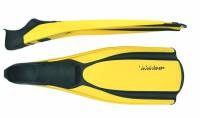In Spring 2002, Marc Habib was a junior majoring in Industrial and Systems Engineering at the University of Southern California. He has enjoyed the sport of diving since the summer of 1999.
Scuba divers rely on diving fins for underwater propulsion. Recent advancements in fin technology have increased divers’ locomotive efficiency, with some designs drawing ideas from structures in nature for improvement. Traditional paddle fins have been modified to include grooved surfaces, pivoting structures, and split designs to maximize forward thrust per kick and reduce energy expenditure.
Introduction
Ever since Jacques-Yves Cousteau invented the first underwater self-contained air regulator in 1943, the popularity of scuba diving has steadily risen. It is estimated that 500,000 people acquire diving certification annually [1]. Scuba diving relies upon several key pieces of equipment to maintain underwater mobility and respiration. Although many consider water fins to be the simplest of these diving gears, they have seen numerous technological advances, becoming highly complex in the process.
The human foot-leg system is not designed for high underwater mobility. Water enthusiasts soon realized that fish have fins for a reason: they are an effective means of underwater propulsion. The adaptation of fish fin structures to human legs was used to bypass this shortcoming (see Fig. 1). With the invention of the water fin, humans gained the ability to move through the water with greater ease, contributing to the continued growth of the scuba diving industry.
Water fins have undergone tremendous changes since their introduction in the early twentieth century. Over the past 30 years, scientists and engineers have made several major improvements to the water fin in an attempt to mimic natural aquatic structures, including material and shape. Split-fin technology, the latest advance in water fins, has taken the diving industry one step closer to achieving this goal, opening up the scuba experience to a greater audience and improving propulsion for existing divers.
Fins: Form and Function
Water fins work by pushing water behind the diver, triggering movement in the opposing direction. Cycling diving fins up and down in an alternating fashion, in what is called the power stroke, propels divers through the water with less effort and greater speed than would feet alone. The advantage of using fins is an increased water displacement that can generate more thrust with each kick.
Unfortunately, there are several limitations to the most effective fin. For maximum efficacy, the fin blade should be perpendicular to movement yet result in a parallel directed force, such as when one paddles a canoe. For horizontal swimming, the paddle fin applies force to the water at a nonzero angle, resulting in more strain and effort for less thrust per stroke. Divers must expend greater energy (especially in the calves and ankles) to keep the fins straight and cycle them up and down (see Fig. 2).
A second limitation faced by traditional fins is inherent to human anatomy. The human leg possesses a limited range of motion and flexibility at each of three major joints (hip, knee and ankle), enabling unidirectional forward movement and encumbering sideways movement. Any direction that the fins cannot be cycled in is also barred from direct travel. Also important, each diver is limited by his or her own personal strength and stamina. Traditional paddle fins are so sufficiently labor intensive that many divers in less than exceptional physical shape can find the activity too exhausting to partake in.
The traditional paddle fin shape also generates significant turbulence (resistance to movement). Consequently, water can “fall” off the sides of the fins, causing them to wobble from side to side, complicating a diver from maintaining an optimum angle [2].
As a result of these shortcomings, millions of dollars have been invested into developing better fins. Many advances have arisen from biomimetics , or the implementation of natural design. In recent decades, several new designs have been introduced, including groove, pivot and split fin technologies.
Traditional Paddle Fins
The original fins made for commercial use fit directly onto the user’s whole foot, worn without any type of boot or supplementary footwear. Made from a stiff plastic and rubber compound, they were designed to work as extensions of the diver’s foot, functioning as “extended paddles.” These worked well for both scuba divers and snorkelers in that they were simple to use, were fairly effective and constituted a significant improvement to the original absence of fins.
Use of these fins proved to be relatively demanding on the body. For each kick cycle, a user needed to use pure leg strength to push the fins up and down. For many, the down stroke is easier than the upstroke. With the paddle fin, the fin functioned directionally independent; each foot stroke was equally difficult [3].
Fins Get Grooves
In 1985 Mares developed a new feature for water fins called channels (see Fig. 3). Traditional paddle fins suffer from water “spilling” off of the edge during the down stroke of the diver’s kick. This loss of water translated into a loss of thrust, meaning that the diver’s effort was not being fully utilized. Mares’ channels work to maximize fluid stream channeling, keeping the water under the fin in place so that it can be displaced during the down stroke. This increase in water displacement allowed for greater thrust levels and improved overall performance.
The addition of channels or grooves made the effort and energy expended by the diver more valuable – more thrust was generated with each stroke. But this advance in technology did not solve the energy inefficiency of the kick cycle upstroke [4].
Pivot Technology
When first using a fin with pivot technology, many divers think they are using a broken fin [5]. During the up and down strokes of the kick, this fin “breaks” to widen the angle of the fin. Rather than remaining rigid as pressure builds under the fin, the new fins are free to snap back from the pressure, allowing a greater angle of motion during the down-stroke of the diver’s kick. An advantage from this break is that the fin can be put in a position that allows for a larger angle with respect to the water [6].
The difference between traditional and pivot fins can be shown by the direction that water is pushed away from the diver with each stroke. With traditional fins, only the very ends of the fin push water in the direction desired. Contrary to desired energy transfer, much of the diver’s effort goes into moving water up and down. With pivot technology, the fin moves far more water in the direction away from the diver, providing more push for each kick.
Split Fins
The latest advance for water fins has come in the past year. Some fin manufacturers decided to depart completely from the paddle fin concept, moving on to the split fin. A split fin may appear like a regular paddle fin cut with a dive knife. In reality, these fins have taken a whole new approach to the way that divers move through the water.
With the split fin, the energy required during the up stroke is greatly minimized. The second half of the fin becomes nearly vertical during the upstroke, cutting the water and facilitating forward movement. During the down stroke, the fin forms a cup that maximizes the amount of water being pushed by the fin during each stroke. This combination of easy up and powerful down strokes has made the introduction of the split fin big news in the diving community [7]. The new split technology has made the kick movement more efficient and less strenuous. By altering fin design, engineers have greatly reduced the amount of wobbling and water spillage occurring with each stroke. This fin takes what engineers began with groove technology one step further by maximizing thrust per unit of energy expenditure.
With this minimization of lost water and energy used, a diver requires less effort to produce the same results as traditional paddle fins. By reducing turbulence, this fin design allows one to expend less energy and air, yielding an easier and more relaxed kick, yet still achieving the same speed and thrust.
Conclusion
Divers have been eager to adopt new diving fin technology in the past and look forward to future developments. Improved fins have increased participation in the sport of diving by facilitating underwater locomotion, thus allowing divers to use less air and remain submerged for longer periods of time.
References
[1] Florida Scuba Hound. “History of Scuba” Internet: http://www.floridascubahound.com/history_of_scuba.htm[Jan. 13, 2003].
[2] Rodale’s Scuba Diving. “The Next Millenium” http://www.scubadiving.com/gear/fins2/, May 25, 2002.
[3] J. Hardy. “8 New Paddle Fins: New models that make fin choice more than a split decision.” Scuba Diving June 2001: 33-34.
[4] D. Taylor. “Split-Fin Smackdown: The new fin technology inspires glowing reviews and harsh criticism. Who’s right?” Scuba Diving, pp. 20, Sept. 2001.
[5] P. Hoover. “Volo Fins.” Sport Diver., pp. 22-23, Jan. 2002.
[6] Mares. “The Mares Advantage.” Internet: http://217.169.126.181/product.asp [March 11, 2002].
[7] B. Courtney. “The Twin Jet Fin by Scuba Pro.” Sport Diver, pp. 11-12, July 2001.



-200x200.jpg)



